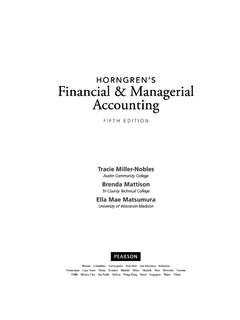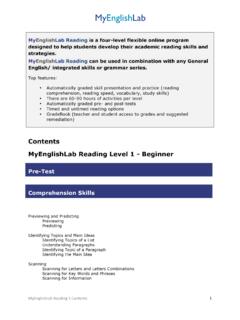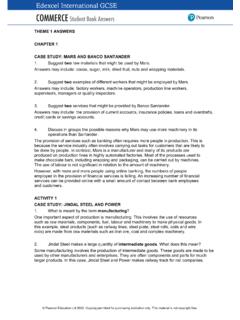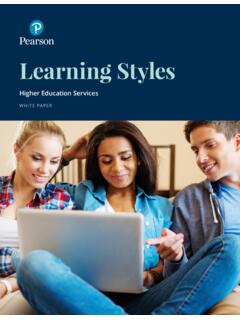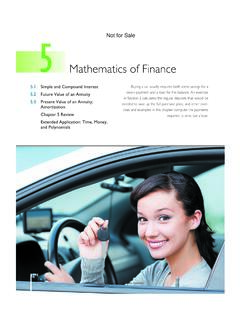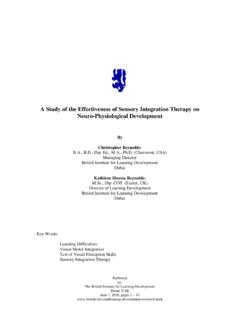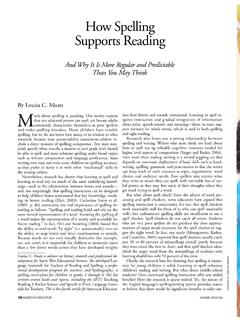Transcription of The Reading Process and ‘The Big Six’ - Pearson
1 The Reading Process and The Big Six This article has been generated from the Research into Practice series by the DECS Literacy Secretariat to foreground current research and implications for practice. It is based on Konza. teaching Reading : Why the Fab Five should be the Big Six . Australian Journal of Teacher Education 39, no. 12 (2014). by Chris Brown Assistant Principal, Bacchus Marsh Primary School, VictoriaIllustration by Kanae SatoIntroductionLearning to read is one of the most important outcomes of education. But Reading is an incredibly complex Process . It s underpinned by oral language skills and involves very specific skill development (phonemic and decoding strategies) and the application of comprehension strategies.
2 In order to teach students to read successfully, educators need to understand the delicate ways in which these skills and strategies work together to meet individual students at their point of the past four decades, numerous large-scale reviews of research into the effective teaching of these skills and strategies have occurred in North America, Britain and Australia. The aim was to provide solid, evidence-based guidelines for education systems 7-12. There s a compelling consistency in the findings that form the base of The Big Six elements listed in this article. ELEMENT 1 Strong foundations - Oral language development and early literacy experiences Oral language is the foundation for learning to read 1-2 and is related to overall Reading progress in primary and secondary schooling.
3 From birth, a child s experiences have an impact on their oral and written language skills. Children who are surrounded by rich and increasingly complex conversations have an overwhelming advantage in vocabulary development, in understanding the structure of language and tuning into the sounds of the English language. Oral language is important for both Reading and writing, and children ELEMENT 2 Early stumbling blocks - Phonological and phonemic awarenessPhonological awareness is a term that refers to the ability to focus on the sounds of speech instead of the meaning of speech. It s a continuous stream of speech that can be separated into individual words , that those words can also be broken up into syllables, and that those syllables are made up of separate, single sounds.
4 The most significant of these components for Reading development is awareness of the individual sounds or phonemes, that is, phonemic awareness. A preschool child s phonemic awareness the single best predictor of their future Reading ability, better than either SES or IQ 2-7. Being able to blend and segment phonemes are the most crucial phonemic skills for Reading and spelling. But some children find it very difficult to hear the separate phonemes because the continuous nature of speech compresses them into a series of overlapping sounds (this is called co-articulation). Speech must be rapid, and nearly overlapping, to be understood.
5 However, while making it easy for the listener, co-articulation disguises the underlying separate phonemes. To detect separate phonemes, the ability to pull apart the Process of co-articulation and hear speech as a series of separate sounds is required. If children can t hear the separate sounds, they can t relate those sounds to letters an enormous stumbling block in learning to read and spell. The explicit teaching of the alphabetic code remains a key element of the Australian a strong vocabulary to understand a broad range of words ; they require strong grammatical skills to understand complex sentences; and they require the ability to reason and infer so that the necessary links between information in texts can be made.
6 The research suggests that core teaching practices and classroom environments must support a commitment to rich dialogue and conversations, in order to create strong foundations. ELEMENT 3 Next steps - Letter-sound and word knowledge = comprehension Once children understand that words can be broken up into a series of sounds, they need to learn the relationship between those sounds and letters the alphabetic code . There s no way to bypass this step in the Reading Process . An understanding of the relationship between sounds and letters that represent them (graphemes) is at the heart of Reading an alphabetic language. This letter-sound relationship is referred to as the alphabetic principle, or more commonly, by TangYau HoongSo how and when should you teach phonics?
7 Most teachers and researchers agree that phonic elements need to be taught at the beginning of a Reading program. There s still debate around how and when they should be taught. Empirical evidence supports a synthetic approach to teaching phonics for beginning and struggling readers 10-13. A synthetic approach teaches single letters and common letter combinations in an explicit manner, and in an order that helps with blending (synthesising) from the first weeks of formal schooling. The early blending component is critical and begins as soon as the children know letters that can be blended into simple vowel-consonant (vc) or consonant-vowel-consonant (cvc) words .
8 As the letter-sound relationships are learned, they are practised in easily decodable text. This type of practice is beneficial to most beginner readers, but most importantly to readers who don t pick up these vc or cvc relationships s not to say the recommendations don t suggest Reading other types of text. They suggest that children should be using their newly developing phonic skills with all types of texts and continue to have high-quality texts read to them. teaching letter-sound relationships involves complicated elements like affixes, Greek and Latin roots, and the teaching of spelling rules essentially word structure.
9 Learning the structure of words at the syllable and morpheme levels helps with word recognition, spelling and vocabulary development. These elements of phonics can be taught in a more embedded or analytic way, because blending and segmenting skills are learned early, and are easily transferred. This more complex teaching can extend into middle and upper primary school. There s another part of letter-sound knowledge sight phonic instruction is necessary to help children become independent readers, it won t help them when they encounter irregular or sight words such as said, was and saw. Unfortunately, these words are some of the most frequent words in the English language.
10 These words must be learned so well that the words are stored in the children s visual memories (or mental lexicons) and are recognisable when Reading . Quick retrieval of whole words from the mental lexicon is where comprehension starts, and the larger the pool of words in a child s mental lexicon, the better their understanding when Reading . sight words should also be taught explicitly and systematically, rather than attempting to teach them when encountered in text. The latter method means that children are trying to focus on one word among many, and in the context of a story it s actually more efficient and easier for most children to learn these words why is this all so important?
